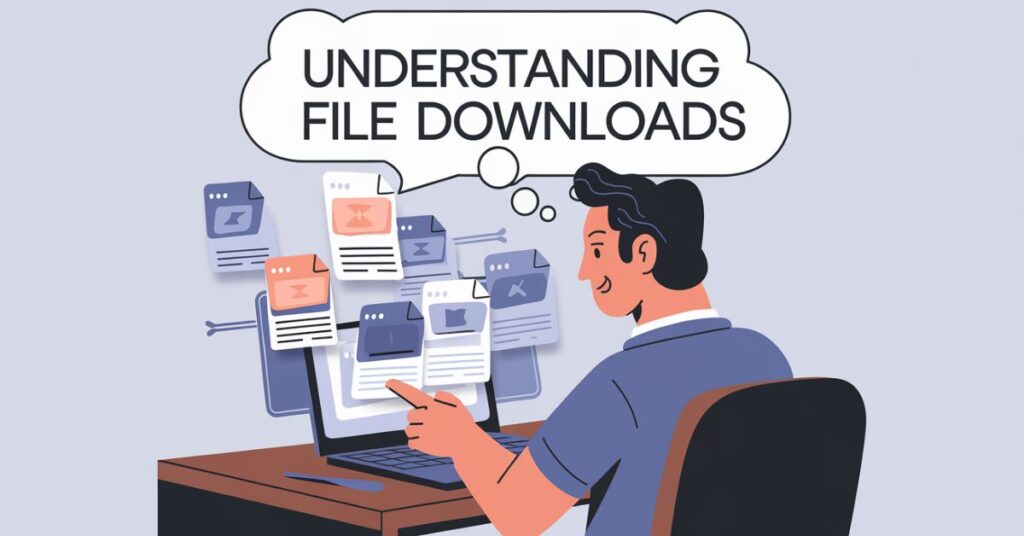Introduction
Downloading and uploading files are key skills for anyone using the internet today.Whether you’re saving a photo from social media getting a document for work or sharing a video with friends you’re dealing with file transfers.
This guide will help you understand how to download and upload files safely and easily.We’ll cover the basics, share helpful tips and answer common questions.
By the end, you’ll feel more confident managing your digital files online.Let’s dive in and learn how to navigate the web like a pro!
Understanding File Downloads

What Is A File Download?
A file download is the process of transferring data from a remote server to your local device.This can include various types of files such as documents images videos software and more.
When you click on a download link or button you’re essentially requesting the server to send you a copy of the file.
Types Of Downloads
- Direct downloads:Files that start downloading immediately upon clicking a link
- Torrent downloads:Peer-to-peer file sharing that involves downloading small pieces of a file from multiple sources
- Streaming downloads:Content that is downloaded and played simultaneously, like YouTube videos
Common File Formats
Understanding different file formats is crucial for managing downloads effectively. Here are some common formats you’ll encounter:
- Documents:.pdf, .doc, .docx, .txt
- Images:.jpg, .png, .gif, .svg
- Audi:.mp3, .wav, .aac
- Video:.mp4, .avi, .mov
- Compressed files:.zip, .rar, .7z
Download Managers
Download managers are software tools designed to help you organize and optimize your downloads.They offer features such as:
- Resuming interrupted downloads
- Scheduling downloads for off-peak hours
- Simultaneous downloading of multiple files
- Automatic virus scanning
Popular download managers include Internet Download Manager Free Download Manager and JDownloader.
Read This Blog:Tech Gaming DefStartup:Revolutionizing The Gaming Industry
Tips For Successful Downloads

1. Verify The Source
Before downloading any file ensure that you’re getting it from a reputable source.Stick to official websites and trusted platforms to minimize the risk of downloading malware or corrupted files.
2. Check File Size And Type
Always review the file size and type before initiating a download.This helps you manage your storage space and avoid downloading incompatible files.
3. Use Secure Connections
Whenever possible download files over a secure connection (HTTPS).This encrypts the data transfer protecting your information from potential eavesdroppers.
4. Keep Your Antivirus Updated
Ensure your antivirus software is up-to-date and set to scan downloaded files automatically.This provides an additional layer of protection against malware.
5. Organize Your Downloads
Create a system for organizing your downloaded files.Use descriptive folder names and regularly clean up your downloads folder to maintain order.
6. Be Cautious With Executable Files
Exercise extreme caution when downloading executable files (.exe, .msi, etc.).These can potentially harm your system if they contain malware.
7. Use Browser Extensions
Consider using browser extensions that enhance download management such as download accelerators or file converters.
Read This Blog:Codes ETrueSports:A Comprehensive Guide To Understanding Them
Understanding File Uploads

What Is A File Upload?
File uploading is the process of transferring data from your local device to a remote server.This is commonly done when sharing files on social media, attaching documents to emails or backing up data to cloud storage.
Types Of Uploads
- Single file uploads:Uploading one file at a time
- Multiple file uploads:Selecting and uploading several files simultaneously
- Drag-and-drop uploads:Dragging files from your computer directly into a web interface
- Cloud-to-cloud transfers:Moving files between different cloud storage services
Common Upload Scenarios
- Sharing photos on social media platforms
- Submitting assignments or reports for work or school
- Backing up important documents to cloud storage
- Uploading videos to streaming platforms
- Attaching files to emails or messaging apps
Upload Limitations
It’s important to be aware of upload limitations which can vary depending on the platform or service you’re using.These may include:
- Maximum file size restrictions
- Allowed file formats
- Total storage capacity (for cloud services)
- Bandwidth limitations
Tips For Successful Uploads

1. Compress Large Files
If you’re dealing with large files consider compressing them before uploading.This can significantly reduce upload time and help you stay within file size limits.
2. Use Reliable Internet Connections
Stable and fast internet connections are crucial for successful uploads especially for larger files.Avoid uploading important files over unreliable Wi-Fi networks.
3. Name Files Descriptively
Use clear and descriptive file names that include relevant information such as date, version, or purpose.This makes it easier to identify files later.
4. Check Upload Progress
Many platforms provide progress indicators for uploads.Keep an eye on these to ensure your files are uploading successfully.
5. Verify Successful Uploads
After an upload is complete double-check to make sure the file has been successfully transferred and is accessible on the destination platform.
6. Understand Privacy Settings
When uploading files to shared platforms or social media be aware of privacy settings.Adjust them according to your preferences to control who can access your uploaded content.
7. Use Cloud Storage Sync Features
Take advantage of automatic sync features offered by cloud storage services.This ensures your files are always up-to-date across all your devices.
8. Be Mindful Of Copyright
Only upload content that you have the right to share.Respect copyright laws and intellectual property rights when uploading files.
9. Backup Important Files
Before uploading important files make sure you have a backup copy stored locally or on a separate cloud service.
10. Use Secure File Transfer Protocols
When uploading sensitive information, use secure file transfer protocols like SFTP (Secure File Transfer Protocol) to protect your data.
Frequently Asked Questions (FAQs)
How Can I Speed Up My Downloads?
Use a download manager, choose a server closer to your location, and ensure you have a stable internet connection.
What Should I Do If A Download Keeps Failing?
Try clearing your browser cache, using a different browser, or downloading the file in smaller parts if possible.
Are There Risks Associated With Uploading Files To The Cloud?
While cloud storage is generally secure, there’s always a small risk of data breaches. Use strong passwords and enable two-factor authentication.
How Can I Ensure My Uploaded Files Are Private?
Check and adjust privacy settings on the platform you’re using, and consider encrypting sensitive files before uploading.
What’s The Difference Between Uploading And Syncing Files?
Uploading is a manual process of transferring files, while syncing automatically updates files across multiple devices or platforms.
Conclusion
Downloading and uploading files are key skills for using the internet.Whether you’re sharing photos, getting work documents, or saving important files knowing how to do this safely and efficiently is crucial.
Remember to always check where your files come from, use secure connections and organize your downloads well.
For uploads, be mindful of file sizes and privacy settings.With these basics in mind, you’ll be better prepared to handle your digital files confidently.Keep learning and stay safe online!

William is a passionate fashion enthusiast with a keen eye for style trends.
With a background in textile design and years of experience in the Tech industry, William brings a unique perspective to his writing. He loves exploring sustainable fashion and street style.








